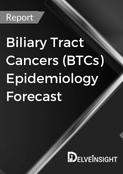Biliary Tract Cancers (BTCs) Epidemiology Forecast 2034
Key Highlights
- BTC encompasses a range of invasive adenocarcinomas, such as cholangiocarcinoma—which originates in the intrahepatic, perihilar, or distal bile ducts—and gallbladder cancer.
- BTC often don’t show noticeable signs or symptoms in the early stages. As the tumor grows, symptoms may develop, such as an abdominal lump or changes in urine. Surgical resection remains the mainstay of cure for BTC.
- In 2024, the 7MM reported approximately 67,000 diagnosed incident cases of BTC, reflecting a moderate yet clinically significant disease burden across these regions.
- Among the EU4 and the UK, around ~22,000 BTC cases were diagnosed in 2024, emphasizing the collective contribution of the EU4 and the UK to the overall BTC incidence in the 7MM.
- In 2024, there was a relatively balanced distribution of BTC subtypes in the 7MM, with roughly 21,000 cases each of gallbladder cancer and intrahepatic cholangiocarcinoma, and around 25,000 cases of other biliary tract cancers, including extrahepatic and ampullary adenocarcinoma.
- Age-based segmentation revealed a steep rise in BTC incidence with advancing age in 2024, as individuals aged =80 years accounted for approximately 24,000 cases and those aged 70–79 years represented 20,000 cases. In contrast, fewer than 3,000 cases were observed in individuals under 50 years of age, indicating low prevalence in younger populations.
- These findings highlight the substantial clinical impact of BTC across the 7MM, with notable geographic, age-related, and molecular variations. The predominance of late-stage diagnoses and high TP53 mutation burden signifies the urgency for improved early detection strategies and the development of targeted therapies tailored to regional and molecular profiles.
DelveInsight’s “Biliary Tract Cancer (BTC)– Epidemiology Forecast – 2034” report delivers an in depth understanding of BTC historical and forecasted epidemiology in the United States, EU4 (Germany, France, Italy, and Spain) and the United Kingdom, and Japan.
The table given below further depicts the key segments provided in the report:
|
Study Period |
2020–2034 |
|
Forecast Period |
2025–2034 |
|
Geographies Covered |
US, EU4 (Germany, France, Italy, and Spain) and the UK, and Japan |
|
Epidemiology |
Segmented by:
|
Biliary Tract Cancer (BTC): Disease Understanding
Biliary Tract Cancer (BTC) Overview,
BTC constitute epithelial malignancies of the biliary tree and include the following: gallbladder cancer (GBC) and cholangiocarcinoma (CCA). CCA is further divided into intrahepatic CCA, perihilar CCA (Klatskin’s tumor), and distal CCA.
The clinical features of BTC depend on the location of the tumor. Most of the tumors are initiated at the hepatic duct bifurcation, and the rest occur in the distal common bile duct or within the liver. Patients with extrahepatic tumors usually present with painless jaundice from biliary obstruction, and patients with intrahepatic tumors usually present with pain.
The molecular pathogenesis of BTC involves two primary mechanisms: chronic cholecystitis due to cholelithiasis and abnormal pancreaticobiliary junction (APBJ). Cholelithiasis-related GBC typically features early p53 mutations but rarely KRAS mutations, while APBJ-associated GBC, more common in younger patients, shows frequent KRAS mutations and late-onset p53 alterations. These distinct pathways highlight differing genetic triggers in GBC development.
Biliary Tract Cancer (BTC) Diagnosis
BTC diagnosis involves a comprehensive range of tools, including endoscopic procedures such as ERCP, cytology, brushing, FISH-polysomy, biopsy, ultrasonography, cholangioscopy, chromoendoscopy, and confocal/narrow-band imaging. Imaging modalities like MRI, CT, MRCP, PET-CT, and endoscopic ultrasound are essential, though they cannot independently confirm malignancy. Blood tests, including liver function panels and nonspecific cancer markers (e.g., albumin, ESR, CRP), provide supportive data but are not diagnostic.
Additional diagnostic techniques include tumor markers (CA 19-9, CA-125), urine- and bile-based biomarker assays, and immunoglobulin G4 testing to rule out IgG4 cholangiopathy. Emerging tools such as cholangioscopy and molecular profiling of bile and serum are under investigation for their diagnostic potential. Despite these options, distinguishing malignant from benign strictures remains a challenge, emphasizing the need for multimodal assessment..
Biliary Tract Cancer (BTC) Epidemiology
The BTC epidemiology chapter in the report provides historical as well as forecasted epidemiology segmented by total incident cases of BTC, total incident cases of BTC by tumor location, age-specific Cases of BTC, mutation-specific Cases of BTC, and stage-specific cases of BTC, in the 7MM covering the United States, EU4 countries (Germany, France, Italy, and Spain), United Kingdom, and Japan from 2020 to 2034.
- In 2024, the United States reported approximately 20,000 incident cases of BTC, representing a significant portion of the overall burden across the 7MM. Most of the cases are relate to people older than 60 years.
- Japan led the 7MM in BTC incidence in 2024, with around 25,000 newly diagnosed cases—reflecting its high disease prevalence and potential regional risk factors.
- Stage-specific analysis from 2024 showed that Stage IV accounted for the largest share of BTC diagnoses in the 7MM, with approximately 20,000 cases—highlighting the challenge of late-stage detection and the need for earlier diagnostic interventions.
- In 2024, TP53 accounted for the highest number of cases, whereas, FGFR accounted for the lowest number of cases as far as mutation-specific cases of BTC are concerned. There were approximately 60,000 and 1,300 cases for TP53 and FGFR, respectively, in the 7MM.
KOL Views
To gaze into the epidemiology insights of the real world, we take KOLs and SMEs’ opinions working in the domain through primary research to fill the data gaps and validate our secondary research on disease incidence.
DelveInsight’s analysts connected with 20+ KOLs to gather insights; however, interviews were conducted with 10+ KOLs in the 7MM. Centers such as the Johns Hopkins Hospital, USA, US; University Medicine Essen - Ruhrlandklinik, Germany; Institut Curi, France; Università Politecnica delle Marche Home, Italy; Arnau de Vilanova University Hospital, Spain; The Institute of Cancer Research, UK; The National Cancer Center Tokyo, Japan and others were contacted. Their opinion helps understand and validate current disease incidence, gender involved with the disease, diagnosis rate, and diagnostic criteria.
Scope of the Report
- The report covers a segment of an executive summary, and a descriptive overview BTC explaining its causes, signs and symptoms, pathogenesis.
- Comprehensive insight into the epidemiology segments and forecasts, the future growth potential of diagnosis rate, and disease progression have been provided.
- A detailed review of current challenges in establishing diagnosis and diagnosis rate is provided.
Biliary Tract Cancer (BTC) Report Insights
- Patient Population
- Country-wise Epidemiology Distribution
Biliary Tract Cancer (BTC) Report Key Strengths
- Ten-year Forecast
- The 7MM Coverage
- BTC Epidemiology Segmentation
Biliary Tract Cancer (BTC) Report Assessment
- Epidemiology Segmentation
- Current Diagnostic Practices
FAQs
Epidemiology Insights
- What are the disease risks, burdens, and unmet needs of BTC? What will be the growth opportunities across the 7MM with respect to the patient population pertaining to BTC
- What is the historical and forecasted BTC patient pool in the United States, EU4 (Germany, France, Italy, Spain) and the United Kingdom, and Japan?
- What is the diagnostic pattern of BTC?
- Which clinical factors will affect BTC?
- Which factors will affect the increase in the diagnosis of BTC?
Reasons to buy
- Insights on disease burden, details regarding diagnosis, and factors contributing to the change in the epidemiology of the disease during the forecast years.
- To understand the change in BTC cases in varying geographies over the coming years.
- A detailed overview of Total Incident Cases of BTC, Total Incident Cases of BTC by Tumor Location, Age-specific Cases of BTC, Mutation-specific Cases of BTC, and Stage-specific Cases of BTC is included.
- Detailed insights on various factors hampering disease diagnosis and other existing diagnostic challenges.


